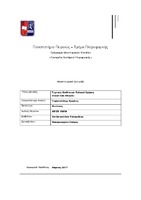| dc.contributor.advisor | Κοτζανικολάου, Παναγιώτης | |
| dc.contributor.advisor | Παπαγεωργίου, Σπυρίδων | |
| dc.contributor.author | Γιαμπουλάκης, Χρήστος | |
| dc.date.accessioned | 2017-12-06T16:23:33Z | |
| dc.date.available | 2017-12-06T16:23:33Z | |
| dc.date.issued | 2017-03 | |
| dc.identifier.uri | https://dione.lib.unipi.gr/xmlui/handle/unipi/10267 | |
| dc.description.abstract | Σκοπός αυτής της διπλωματικής εργασίας είναι να διερευνήσει ένα νέο είδος διαδικτυακών επιθέσεων που
βρίσκεται στην ακμή του. Οι επιθέσεις που θα εξετασθούν εκτελούνται στην πλευρά του τελικού χρήστη (ή
καλύτερα με τη βοήθεια του τελικού χρήστη), για αυτό το λόγο ονομάζονται επιθέσεις τελικού χρήστη (client side
attacks). Σκοπός του επιτιθέμενου είναι να ξεγελάσει/χειραγωγήσει με ποικίλους τρόπους τον τελικό χρήστη να
πράξει λανθασμένα, και τελικά να λάβει πρόσβαση στο σύστημα του. Μπορούμε να χωρίσουμε το περιεχόμενο
της συγκεκριμένης διπλωματικής εργασίας σε τρία μέρη.
Στο πρώτο μέρος εξηγούνται οι λόγοι που οι επιτιθέμενοι πλέον προτιμούν τις επιθέσεις σε χρήστες, αντί
για επιθέσεις σε συστήματα (server side), και αναφέρονται τα κίνητρα των επιτιθέμενων. Έπειτα περιγράφεται το
γενικότερο μοντέλο μιας τέτοιας επίθεσης και οι λόγοι που έχουν μεγάλη πιθανότητα επιτυχίας. Τέλος,
αναλύονται οι επικρατέστερες τεχνικές επιθέσεων τελικού χρήστη με ξεχωριστή αναφορά στις μεθόδους
κοινωνικής μηχανικής και προτείνονται εργαλεία για κάθε περίπτωση.
Στο δεύτερο μέρος, που αποτελεί το πρακτικό κομμάτι, προσομοιώνονται σε εργαστηριακό περιβάλλον
συνδυαστικές επιθέσεις τελικού χρήστη με σκοπό την απομακρυσμένη πρόσβαση στο μηχάνημα-στόχο. Σε κάθε
σενάριο επίθεσης εξετάζεται το κομμάτι της κοινωνικής μηχανικής.
Στο τρίτο και τελευταίο μέρος προτείνονται τεχνικές μείωσης της επιτυχίας των επικρατέστερων
επιθέσεων τελικού χρήστη αλλά και τρόποι προστασίας των τελικών χρηστών. | el |
| dc.format.extent | 59 | el |
| dc.language.iso | el | el |
| dc.publisher | Πανεπιστήμιο Πειραιώς | el |
| dc.rights | Attribution-NonCommercial-NoDerivatives 4.0 Διεθνές | * |
| dc.rights.uri | http://creativecommons.org/licenses/by-nc-nd/4.0/ | * |
| dc.title | Τεχνικές επιθέσεων τελικού χρήστη | el |
| dc.title.alternative | Client side attacks | el |
| dc.type | Master Thesis | el |
| dc.contributor.department | Σχολή Τεχνολογιών Πληροφορικής και Επικοινωνιών. Τμήμα Πληροφορικής | el |
| dc.description.abstractEN | This thesis scope is to look into a new, fast growing kind of cyber-attacks. These attacks are performed on the client
side (or better by the end user); that is the reason they are called client side attacks. The attacker's target is to
deceive/manipulate in various ways the end user so as to act carelessly, and to finally take over his system. The
contents of this thesis could be divided in three parts.
The first part seeks out to explain the reasons why this kind of attacks is so preferable, instead of serverside
attacks, and to present the motivations of the attackers. Afterwards, the generic model of a client side attack is
described and the reasons behind the high success rate of such an attack are analyzed. Furthermore, the
predominant and state-of-the-art techniques for client side attacks are analyzed with a separate part on the social
engineering methods. Also, different tools for each technique are suggested.
At the second part, which is the practical one, combined client side attacks are simulated in a lab. The
attacker’s main objective is to achieve remote access of the target's machine. In every scenario in the lab the social
engineering part is thoroughly examined.
At the third and final part, mitigation techniques are proposed in order to protect the end user and reduce
the success rate of client side attacks. | el |
| dc.contributor.master | Προηγμένα Συστήματα Πληροφορικής | el |
| dc.subject.keyword | Επιθέσεις διαδικτυακών εφαρμογών | el |
| dc.subject.keyword | Επιθέσεις τελικού χρήστη | el |
| dc.subject.keyword | Προσομοίωση | el |
| dc.subject.keyword | Κακόβουλο λογισμικό | el |



